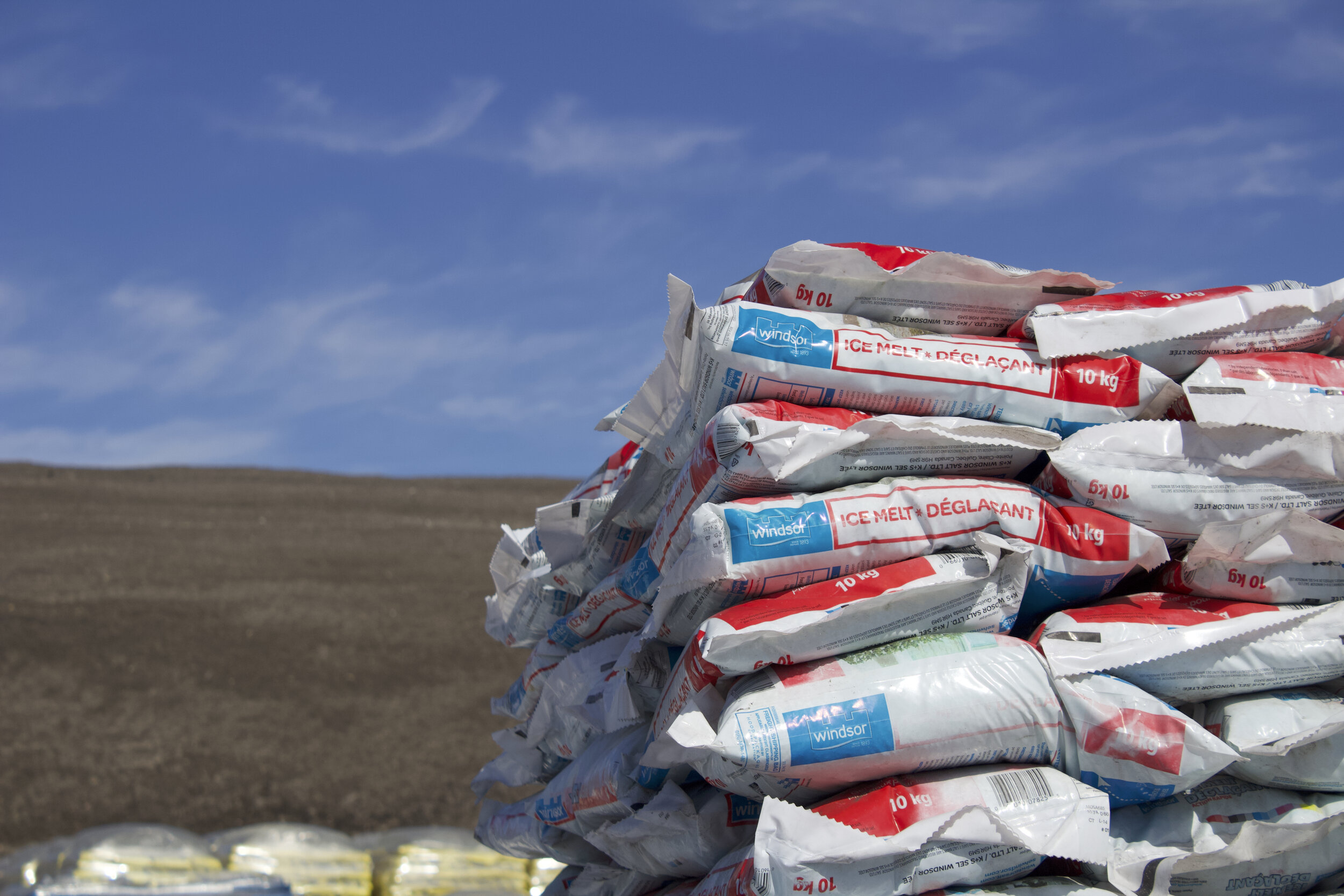Encounters with Urban Glaciers: Notes Toward an Ethnography of the Snow Dump
BY TRICIA TOSO & PIER-OLIVIER TREMBLAY
We begin our story in the parking lot of a Windsor Salt Company distribution centre located in what is known today as Montreal, Canada [1]. On the other side of a chain link fence are hundreds of pallets of market-ready bags of salt for consumers to buy and spread over the sidewalks and entrance ways of their homes and businesses. Towering over us, at about 30 metres high, is the ridge of an enormous pile of compacted snow; about 885,000 cubic meters of the approximately 13.5 million cubic meters of snow the city clears from the streets and sidewalks every winter ends up here. The close proximity of stacks of “Ice Melt” salt to this curious icy bio-cultural artefact offers an ironic avenue of inquiry into the snow practices of settler-colonial winter cities. For the past two winters, the Montreal Waterways research group from Concordia’s Ethnography Lab has been engaged with a number of questions about the cultural framing and ideologies, politics and policies, temporalities and lived realities of snow in an urban environment. The question: “where does the snow go?” brought us here, to the industrial zone of the Montreal borough, Anjou, one chilly March morning.
This giant, hulking, toxic glacial entity is more than just a pile of snow; it is an affordance of the colonial settler state’s infrastructure, and an economy based on the extraction and the transportation of natural resources. As Wiona LaDuke and Deborah Cowen argue, the implementation and maintenance of the infrastructure needed for resource extraction has long been integral to the settler-colonial endeavour to lay claim to the land, waters, and resources while displacing and destroying Indigenous life [2]. It has also created an environment in which snow becomes an obstacle, something undesirable; it mutates into waste. Heather Rogers suggests that through waste “we can read the logic of industrial society’s relationship to nature and human labour” [3]. Through an analysis of the ways in which labour and land, production and consumption, and the past and futures of land are embedded within garbage, Rogers offers a critique of a culture that has accepted trash as inevitable, almost natural [4]. Can the same be said of snow? Is its waste inevitable?
Urban snow dumps represent a particular assemblage of land and water, infrastructure and labour, technologies and municipal policies; historical practices and future imaginaries. It speaks to a multitude of other places: the small, plexiglass cabs of Montreal snowploughs; municipal administration boardrooms and offices; a giant undersea rock salt mine in the St. Lawrence seaway; the Athabasca oil sands on traditional Cree, Dene, and Métis lands to name only a few, and yet it appears ordinary, banal, almost as unremarkable as the bedraggled trees and the ditches of phragmites that surround it. The wasting of snow is mundane, a necessary cost of modern urban life.
We study the smudged geometry, shifting patterns and variations in colour and texture: here smooth, here white, here dark, here the sound of melting water, and we are reminded, in a peculiar and unsettling way, of real glaciers and their retreat. Unlike many other forms of environmental damage like the presence of synthetic hormones, antibiotics and agricultural runoff in rivers, lakes, and oceans, or the thinning of the ozone layer, the impact of human activity on glaciers can be seen, measured, photographed, and documented. This visual accessibility is, in part, why glaciers have become such a matter of public concern while other forms of environmental damage still remain out of view, largely unperceived [5]. The location of urban glaciers on the city’s outskirts, often in low-income neighbourhoods and/or industrial zones, tells us they are not meant to be seen, studied, or photographed; we wonder what it means to be here. Our photos of these urban glaciers locked behind fences, razor wires and surveillance cameras, look almost subversive.
Glaciers form when snow accumulates enough to create compression, allowing the snow to recrystallize, intensifying density and compression so that the snow remains through the changing of the seasons. Once it reaches a critical thickness of about 30 metres, the ice begins to buckle, warp and flow, and begins to move with gravity down mountain slopes [6]. Some of the urban glaciers on the island of Montreal, in particular the largest site located in a former limestone quarry in St. Michel, achieve a 30-metre height, and a density that ensures they survive the warmer months into the following winter. Because of this, and their uncanny evocation of glaciers, we begin to refer to the snow dumps as urban glaciers. We study and photograph their pyramidal forms, and icy precipices, the various fissures, ragged rifts and drifts, and we are surprised at how organic they sometimes appear, yet they are composites of snow and ice; road salt and grit; plastic and paper debris; oils and mineral fats from vehicles; lead, manganese, iron, chromium from corroding metals; polycyclic aromatic hydrocarbons from exhaust fumes and much more. These urban glaciers share the legacy effects of toxic landfills [7].
There are many ways in which glaciers are culturally understood. Sometimes they are positioned as the backdrop for adventure and exploration, featured on tourist brochures and in National Geographic articles, appearing inert and permanent, the perfect grounds for a range of human activities. However, there are other ways in which glaciers are perceived, understood, and represented. Julie Cruikshank’s work and engagement with Tlinget women generously offers readers a very different way to understand glaciers. Glaciers are not hapless victims of climate disruption, but they are “wilful, sometimes capricious, [and] easily excited by human intemperance” [8]. They have agency, they listen and communicate.
Urban snow dumps are certainly not tourist attractions, nor do they typically attract scientific or anthropological interest. They are largely understood as technical problems, an issue for municipal policies and practices; something “out of place”. Access to snow dumps is strictly prohibited; a city worker tells us there is always danger of an avalanche. Most of our interactions with urban glaciers are through fencing and at some distance, we have limited access to their stories, but we listen and watch anyway.
Glaciers have memory, stories, and narratives. They tell the earth’s history, and have shaped landscapes over centuries, but today most of the world’s glaciers are melting, and alarmingly so. According to a recent study, human-driven global heating has led to a melting rate that has doubled in the past 20 years with about 268 gigatonnes of ice lost per year [9]. Glaciers are becoming an endangered species, and might be understood as barometers for the coming natural and social catastrophes [10].
Urban glaciers embody an entirely different relationship to space and time. They emerge out of a modern desire for speed and unhindered mobility, and are the highly polluted by-product of infrastructure designed to function independently of the cyclical temporality of Montreal’s climate. They are, on the surface, a technical solution to a technical problem.
This line of inquiry has brought us into relation with urban glaciers around the city and seasons. We’ve developed relationships with some of them, returning again and again to assess their seasonal growth or diminution, and participate in the life and activity of the sites. Some urban glaciers live all year long, but most melt over the warmer months. Released from the icy grip of the urban glacier, the water runs freely over the asphalt to either a storm sewer, destined for the city waste management plant, or run into ditches and seep into the earth. The melted water leaves a heap of garbage behind, and reenters the hydrologic cycle, carrying a range of pollutants including nitrogen and sulfur dioxides, benzene, and formaldehyde, all of which are toxic for aquatic life. Max Liboiron writes that pollution is not a “side effect” of colonialism, but is consistent with colonial relations to land; that pollution is colonialism [11].
The messages of glaciers are complex, but one thing is clear is that human activity is having a devastating impact. The gravity, immensity, and duration of glaciers makes it hard to grasp; we understand so little of the earth’s ancient cryospheres. The urban glacier, however, seems to offer another approach to the problem of climate devastation. These great, black, toxic hulks of sacrificed snow offer lessons on the violence of the occupation and degradation of these lands and waters, and perhaps if we focus on their extinction, we can begin to restore our relations with glaciers.
TEXT AND PHOTOGRAPHS BY TRICIA TOSO & PIER-OLIVIER TREMBLAY
[1] The use of ‘we’ in this text refers to the authors, both settlers living in Tiohtiá:ke, traditional territory of the Kanien’kehà:ka.
[2] LaDuke, W. & Cowen, D. (2020). Beyond Wiindigo Infrastructure. The South Atlantic Quarterly. 119 (2); 243-268. Invoking the cannibal monster of Anishinaabe stories, LaDuke, economist and Anishinaabekwe (Ojibwe) member of the White Earth Nation draws parallels between the insatiable appetite of the Wiindigo and petro-capitalism. She and Cowen extend this parallel to extractive energy infrastructure such as pipelines.
[3] Rogers, H. (2005). Gone tomorrow: The Hidden life of Garbage New York & London: The New Press, p. 16.
[4] Ibid. p. 102.
[5] Orlove, B., Wiegant, E., Luckman (Eds) (2008). Introduction. Darkening Peaks: Glacier Retreat, Science, and Society. University of California Press.
[6] This definition is from the National Snow and Ice Data Centre: https://nsidc.org/
[7] Tsing, A. L., Deger, J., Saxena, A. K., & Zhou, F. (2020). Feral atlas: The more-than-human Anthropocene. Stanford University Press. http://bibpurl.oclc.org/web/95602 http://feralatlas.org
[8] Cruikshank, J. (2005). Do Glaciers Listen? Local Knowledge, Colonial Encounters, and Social Imagination. Vancouver: UBC Press, p. 5.
[9] Hugonnet, R., McNabb, R., Berthier, E. et al. (2021) Accelerated global glacier mass loss in the early twenty-first century. Nature 592. https://doi.org/10.1038/s41586-021-03436-z.
[10] Cruikshank (2005).
[11] Liboiron, M. (2021). Pollution is Colonialism. Duke University Press. Colonialism in Canada is always about Indigenous land and the ways it has been parcelled off by the state into property, resource, or as a sink for waste. Capitalism has flourished within settler-colonial relations (or lack thereof) with Land.
Pier-Olivier Tremblay is a SSHRC grant holder and doctoral student in Social and Cultural Analysis at Concordia University. He holds a Master in sociology from Université du Québec à Montréal, and is currently a member of the Waterways working group at the Concordia Ethnography Lab. His research focuses on human/non-human affective relationships, infrastructure and adaptation to climate change in urban areas.
Tricia Toso is a PhD candidate in Concordia’s Communications Studies program located on the traditional territories of Kanien'kehà:ka. Her research focuses on the coloniality of Canadian infrastructure and the policies that regulate it. Engaging with a range of methodologies, her research and creative work explores the potential for developing new relationships with infrastructure and policy processes that will foster the work of decolonization and reconciliation. Her work includes a number of infrastructural systems including transportation, water and wastewater management, radio, and telecommunications.








